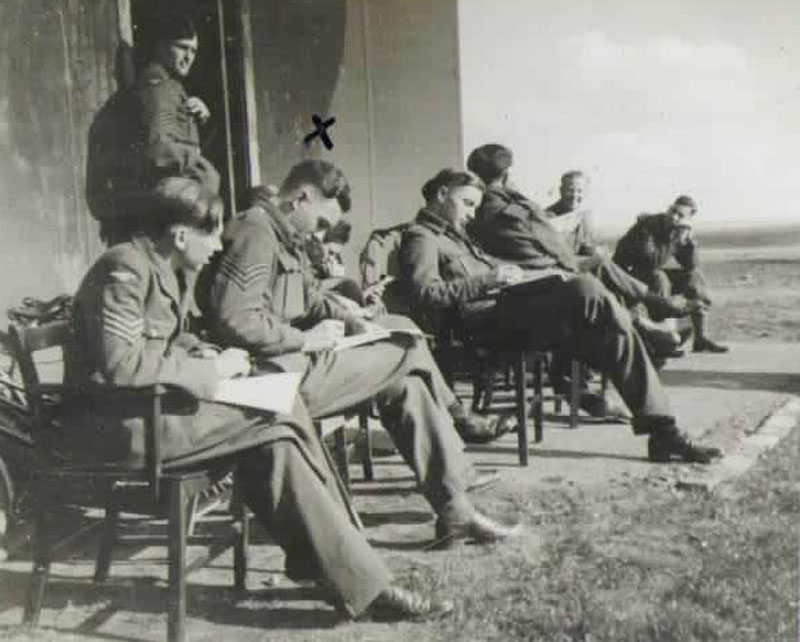Halifax W1221 damaged by flak, returned to East Moor airfield.
On the evening of 2nd October 1942 this was one of four 158 Squadron aircraft that were to be used on a raid to bomb Krefeld. One of the four aircraft did not take off leaving three to make the flight. Halifax W1221 took off from East Moor at 18.28hrs, the crew located the target area and released their bomb load from 12,000 feet at 20.45hrs but just prior to releasing the bomb load the aircraft was hit by flak in the starboard outer engine. The bomb load was released but two hung-up in the aircraft and a return to East Moor was safely made, they landed at 23.45hrs. The damage was repaired but the damaged engine was replaced.
Pilot - Sgt Sydney Henry John White RAFVR (1259712).
Flight Engineer - Sgt Nicholas Pringle RAFVR (1211131).
Navigator - Kenneth Charles Hammond RAFVR (1380337).
Bomb Aimer - P/O Ronald George Woods RAFVR (120667).
Wireless Operator / Air Gunner - Sgt Arthur Thornton Smith RCAF (R/78011).
Mid Upper Gunner - Sgt Thomas Leslie Gray RAFVR (1416025).
Rear Gunner - Sgt Henry Berryman Moorshead RAFVR (1339757).
Sydney White was born in Greenwich in 1916, he had received a commission to the rank of P/O on probation (emergency) on 2nd January 1943.
Kenneth Hammond had received a commission to the rank of P/O on probation (emergency) on 31st December 1942.
Ronald Woods had received a commission to the rank of P/O on probation (emergency) on 17th May 1942, he rose to F/O on probation (war subs) on 17th November 1942
Nicholas Pringle was possibly born in Chester le Street, Durham in 1921, nothing more is known about him.
Kenneth Hammond in marked in this photograph with an "X" and kindly shared by Mr Peter Kefford whos father was also a navigator in No.4 Group RAF around the same time. Should anyone
be able to date or identify anyone else on the photograph I would like to hear from you.
Sadly three months later P/O White, P/O Hammond (28), P/O Woods (20), Sgt Gray (21), Sgt Pringle and Sgt Moorshead (24) were still serving with 158 Squadron when they failed
to return from an operational flight to bomb Lorient on 29th January 1943. Their aircraft, Halifax DT681, crashed in France. White has no known grave and the others are buried
at Plougasnou Communal Cemetery, France.

Arthur Smith was born in Toronto in 1922 and enlisted there in October 1940. He began his first Tour with 158 Squadron on 25th June 1942 and completed it on 12th March 1943. After
a period of non-operational flying he was posted to 433 Squadron and began his second Tour on 5th August 1944 and when he was recommended for a DFC on 6th November 1944 he was twenty
flights into his second Tour. The DFC notification was printed in the London Gazette on 20th February 1945 and by this time he had flown further operational flights, the citation
reads.. "This Warrant Officer has now completed his tour of operations comprising of thirty and one half trips over enemy territory and involving a wide variety of well defended targets
in Germany and France." The recommendation made by his commanding officer added further detail, it reads.."Throughout his tour Warrant Officer Smith has displayed outstanding fortitude and skill, and his splendid example of cheerful courage, co-operation and devotion to duty has been an inspiration not only to his fellow crewmen, but to the squadron in general. This Warrant Officer
has flown with many crew throughout his tour and I consider his fine offensive spirit and splendid record of achievement fully merits the award of the Distinguished Flying Cross."
After the War he returned hom to Toronto where he died in February 1995. Hugh Halliday's thorough RCAF awards research has been used in compiling Arthur Smith's biography.
Halifax W1221 was built to contract B.982938/39 by English Electric Co.Ltd. at Samlesbury and was awaiting collection on 17th July 1942. Two days later it was taken on charge by 158 Squadron at East Moor and received the squadron code "NP-R". On 6th August 1942 it suffered minor damage on Ops to Duisburg that resulted in Cat.Ac/FB damage be the damage assessment. A repair on site was carried out and it was returned to 158 Squadron at East Moor on 1st September 1942 but it's squadron code was then changed to "NP-B". On 2nd October 1942 it sustained flak damage on an operational flight to Krefeld. Cat.Ac/FB damage was again the damage assessment and it was repaired on site. 158 Squadron moved to Rufforth on 6th November 1942 and five days later the aircraft was returned to them, again the squadron code changed, to "NP-M" this time. On 28th February 1943 158 Squadrom moved to Lissett. It sustained flak damage on 28th March 1943 on an operational flight to Berlin. Cat.Ac/FB damage was again the damage assessment and it was again repaired on site with it being returned to 158 Squadron on 29th May 1943. On it's return the squadron code was changed to "NP-H". On 14th September 1943 the aircraft was transferred to 1654 Heavy Conversion Unit at Wigsley.
It was transferred to 1668 Heavy Conversion Unit on 30th September 1943 and then to 1656 Heavy Conversion Unit at Lindholme in November 1943. On 6th January 1944 it received a Cat.Ac/FA damage assessment again though how this occurred is not yet known. It was repaired on site and returned to 1656 HCU on 2nd February 1943. On 20th February 1944 it received a Cat.Ac/FA damage assessment again though how this occurred is not yet known. It was again repaired on site and returned to 1656 HCU on 15th April 1944. On 13th August 1944 it appears to have failed some form of assessment or inspection that saw Cat.B damage be the assessment. During the repair it was deemed unworthy of repairing and was struck off charge on 1st September 1944.